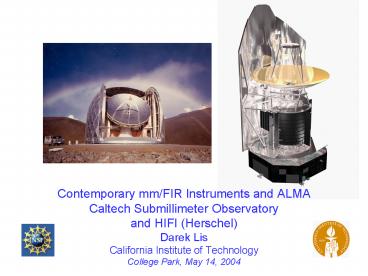Contemporary mmFIR Instruments and ALMA - PowerPoint PPT Presentation
Title:
Contemporary mmFIR Instruments and ALMA
Description:
Contemporary mmFIR Instruments and ALMA – PowerPoint PPT presentation
Number of Views:43
Avg rating:3.0/5.0
Title: Contemporary mmFIR Instruments and ALMA
1
- Contemporary mm/FIR Instruments and ALMA
- Caltech Submillimeter Observatory
- and HIFI (Herschel)
- Darek Lis
- California Institute of Technology
- College Park, May 14, 2004
2
Herschel Space Observatory
- ESA cornerstone mission first space facility to
completely cover the 60670 µm spectral range - Telescope 3.5 m Ø, passively cooled to 80 K
- Orbit Lissajous around L2 very stable and low
background - Larger telescope than other missions (IRAS, ISO,
SWAS, Spitzer, Astro-F,) - Colder aperture, better site, more observing
time than balloon and airborne instruments (1000
SOFIA flights/year) - Lifetime gt3 years Ariane 5 2/15/2007
- Three cryogenically cooled instruments, PACS,
SPIRE (bolometers), and HIFI (heterodyne)
3
HIFI Top-Level Requirements
Sensitivity
- Frequency coverage
- Bands 15 (SIS) 4801250 GHz (625240 ?m)
- Band 6 (HEB) 14101910 GHz (212157 ?m)
- Near-quantum noise limit sensitivity (goal
lt3h?/k) - Instantaneous IF bandwidth (in 2 polarizations)
4 GHz
- Frequency Resolution 1 MHz (WBS), 140 kHz / 280
kHz (HRS) - Calibration accuracy 10 baseline, 3 goal
4
Who are involved?
- HIFI Principal Investigator Thijs de Graauw
- Three Co-Principal Investigators Tom Phillips
(USA), Jürgen Stutzki (D), Emmanuel Caux (F) - Dedicated Project Scientist Xander Tielens
- About 100 astronomical Co-Investigators
- Over 10 countries and 22 institutions involved in
hardware development
5
The Heterodyne Consortium
SIRONI
6
HIFI Core ScienceLife Cycle of Gas and Dust
- ISM in Galaxies
- Normal galaxies
- Physical properties of star-forming ISM
- ISM in the Milky Way
- Structure
- Dynamics (pressure)
- Composition (gradients)
- Dense cores and star-formation
- Dynamics
- Role of Water
- Disks
- Solar System
- Water in Giant Planets
- Comets
- Chemistry
- Martian atmosphere
- Late stages of stellar evolution
- Winds
- Shells
- Asymmetries
- Composition
7
HIFI ? Water
SWAS Neufeld et al. (2000)
ISO/LWS W Hya, Barlow et al. (1996)
- ISO high-energy water lines (warm ISM), low
spectral resolution - SWAS low-energy lines, high spectral resolution,
but low spatial resolution
8
The HIFI Advantage
- High resolving power
- High sensitivity
- Wide frequency coverage
- Small beam
9
The Water Universe
- Half of HIFI water lines are in Band 6
- Back-bone lines
- Probe T200700K water
- OH and H3O for detailed investigation of water
chemistry
10
HIFI ? Unbiased Spectral Line Surveys
- Spectral surveys give an unbiased inventory of
almost all constituents of the interstellar gas - Several 1000s of lines are expected in sources
like Orion-IRc2, Sgr-B2 and IRC10 216 - Other sources are expected to show (much) fewer
lines, due to excitation, chemistry and
beam-filling - Improved pointing, relative calibration, sideband
ratio compared to ground based surveys
CSO Spectrum of Orion 8 nights HIFI expected
less than 1 hour Total HIFI range in 12 hours
Schilke et al. (2001)
11
HIFI and ALMA
- HIFI science unique the only opportunity to
explore the full submm/FIR spectral range in the
foreseeable future - Detailed information about source structure
(morphology, excitation conditions, kinematics)
required to properly analyze HIFI data - Need complementary data from ground based
facilities, such as ALMA
12
CSO Current Status and Future Upgrades
- New surface control system (50 improvement in
aperture efficiency at 350 µm) - Two new bolometer cameras, SHARC II and BOLOCAM
- 48 GHz IF upgrade under way
- 345 GHz 4-channel, dual polarization,
cross-correlating Rx under development - Z-spec (low-resolution grating spectrometer
200300 GHz instantaneous coverage) under
development
13
CSO Bolometer Cameras
- SHARCII 12?32 pixels 360 mK pop-up bolometers
(Goddard) 350 µm 9?? FWHM best weather NEFD 1
Jys½
- BOLOCAM 144 spider-web bolometers (JPL) 1.1 and
2.1 mm 30?? FWHM at 1.1 mm best weather NEFD 68
mJys½
AC biased detectors chopping not required
14
SHARC II Science
Houde et al. (2003) Dowell et al. (in prep
rms 5mJy)
15
Antennae (NGC 4038-9)
Color image 15 µm, Mirabel et al.
(1998) Contours CO 1?0, Wilson et al. (2000)
Dowell et al. (in prep rms 20mJy)
16
Lockman Hole East
A. Kovacs thesis
17
BOLOCAM Science
M. Enoch thesis
- Perseus/Serpens wide-field mapping (Spitzer
Legacy c2d Program) - Lockman Hole 0.1 sq. deg., rms 1 mJy, a dozen
candidate sources
18
Progress in Bolometer Technology
- Transition to filled arrays (FOV considerations)
- Expect tremendous increase in mapping speed
19
Heterodyne Instrumentation Upgrade
- Achieved optimum per-pixel sensitivity
- Increase in bandwidth
20
CSO Sidecab Instrumentation
- 230, 350, 460, and 650 GHz broadband balanced
mixers - Continuous frequency coverage 180730 GHz
- Tunerless, twin SIS junction mixer design
- Dual frequency operation
- Junctions fabricated at JPL
- 48 GHz InP based low-noise amplifiers
21
Galaxy Rx
- 4 channel, dual polarization, continuous
comparison Rx - Tunerless mixers (not balanced)
- 48 GHz IF
- Expected sensitivity gain a factor of 5 compared
to the existing tuned waveguide Rx - 100 µK (100MHz) in 8 hours Integration
22
Spectroscopy at the CSO
- Deuterium fractionation (ND3, D2S, H2D, D2H)
- Line surveys (sideband deconvolution techniques
for HIFI)
23
Atacama Telescope
- CSO capabilities may be transferred in the future
to the 25-m Atacama Telescope - MOU between Cornell and Caltech for a two-year
feasibility study signed - Science working groups established (main drivers
cosmology, wide-field continuum imaging, 200 µm
window) - Site evaluation starts later this month
- Long-term goal is to develop the 25-m, including
the instrumentation
www.astro.cornell.edu/research/projects/atacama































